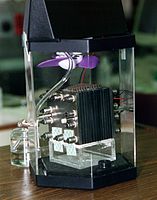
Photo from wikipedia
Abstract In this work, pure and (Fe, Ni) co-doped Co3O4 nanostructured photoelectrodes of different doping levels and thicknesses were manufactured at constant substrate temperature (450 °C) using the spray pyrolysis technique.… Click to show full abstract
Abstract In this work, pure and (Fe, Ni) co-doped Co3O4 nanostructured photoelectrodes of different doping levels and thicknesses were manufactured at constant substrate temperature (450 °C) using the spray pyrolysis technique. In addition to the chemical compositions; the structural, optical, electrical, and photoelectrochemical (PEC) properties were investigated through the use of various analysis techniques. By increasing the codpoing ratio to 6%, the low energy band gap is decreased from 1.43 to 1.3 eV and the high energy bandgap is increased from 2.63 to 2.87 eV, in addition to the reduction in particle size from 30.2 to 12.0 nm. The high energy gap vanishes by increasing the codoped film's spread volume to 60 ml. X-ray photoelectron spectroscopy of 6%(Fe, Ni)-60ml Co3O4 confirms the existence of Ni2+,3+ and Fe2+,3+. Among the studied photoelectrodes, the 6%(Fe, Ni)-60ml Co3O4 photoelectrode displays a photocatalytic hydrogen output rate of 150 mmol/h.cm2 @-1V in 0.3M Na2SO4 electrolyte. The photocurrent density of 6%(Fe, Ni)-60ml photoelectrode reached up to 13.6 mA/cm2@-1V with an IPCE (incident photon to current conversion efficiency) of ∼42%@405 nm and STH (solar to hydrogen conversion efficiency) of ∼11.37%, which are the highest values yet for Co3O4-based photocatalysts. The value of ABPE(applied bias photon-to-current efficiency) is 0.34%@(-0.28V and 636 nm). Interestingly, this photoelectrode shows a photogenerated current density of −0.14 mAcm−2 at 0 V and a PEC current onset over 0.266V. The thermodynamic parameters, corrosion parameters, PEC surface areas, Tafel slopes, and impedance spectroscopies are also being studied to confirm and classify the PEC H2 production mechanism. The 6%(Fe, Ni)-60ml Co3O4 photoelectrode stability/reusability shows only a 6.6% reduction in PEC performance after ten successive runs at -1V with a corrosion rate of 1.2 nm/year. This work offered a new codoping strategy for the design of a highly active Co3O4 based photocatalyst for the generation of solar light-driven hydrogen.
Journal Title: International Journal of Hydrogen Energy
Year Published: 2021
Link to full text (if available)
Share on Social Media: Sign Up to like & get
recommendations!